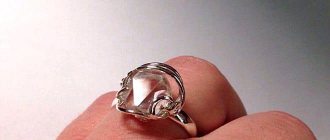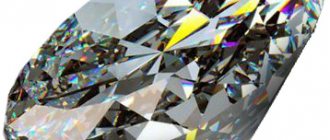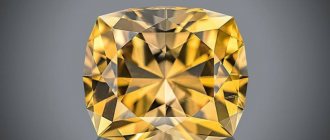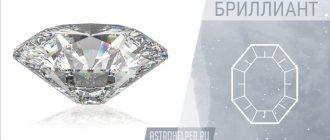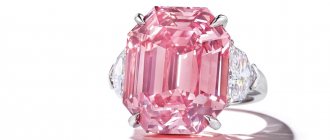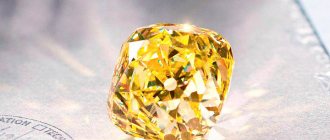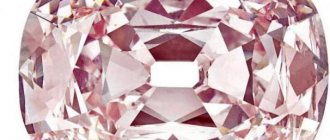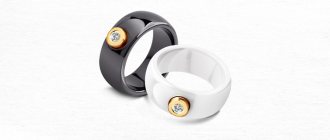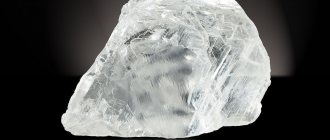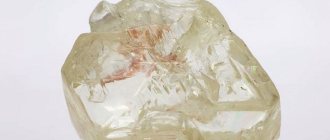The Heart cut shape is considered the most romantic among the others. Jewelry with a heart-shaped stone has become a very popular gift for Valentine's Day and other important dates that mark significant moments in a love relationship. The heart shape is most popular for pendants and rings, and is sometimes used in earrings.
See all jewelry with Heart-shaped stones in the SUNLIGHT catalog
Signs
There is such a sign: if you find a stone in the shape of a heart, you will soon find your soulmate. At the same time, it is believed that whatever the stone is, such will be the relationship in the couple: if the edges of the find are clear and beautiful, then the chosen one will be loving and reliable, and if the edges are uneven and rough, then the relationship promises difficulties. It’s difficult to say how true this sign is, but if a girl wears jewelry with a precious or jewelry stone in the shape of a heart, especially a necklace (like this one), then she has every chance of attracting the attention of the opposite sex.
In addition, there are stones that are traditionally credited with the magical ability to bring happiness in love. These are rose quartz, kunzite, turquoise, pearls, coral.
Types of diamond cuts
Round cut diamond
Until the early 20th century, diamond cut shapes evolved empirically as craftsmen sought to achieve the optimal sparkling effect. It was only since 1910 that theoretical calculations began to be used, taking into account the optical-physical properties of diamonds - such as light refraction, dispersion and hardness - to achieve the greatest sparkle through the appropriate relationships of proportions and symmetry. The pioneer of diamond cutting was a scientist of Russian origin, Marcel Tolkovsky, who in 1919 was the first to calculate the almost ideal parameters for cutting a round diamond. Today, the Tolkowsky diamond is considered the "standard" cut in America and is the basis for cut evaluation. Of all the different cut shapes, the circle cut is the classic cut.
85% of all diamond sales in the world come from round stones. Natural diamonds do not come in a round shape, so when creating a diamond, a significant amount of the weight of the original diamond is lost, resulting in a high cost for the finished round diamond. The round shape gained its popularity due to its optical properties, i.e. sparkling, scintillation, play of light. Another advantage of round diamonds is the ability to use a more elegant type of setting for them, which will not cover up all the luxury of the multi-faceted brilliance of the diamond.
Princess cut diamond
The princess cut is the most popular cut after the round brilliant. The high-quality sparkle and unique Princess shape make it a favorite diamond cut for engagement rings.
The “Princess” is traditionally square in shape and has sharp corners. The diamond follows the natural shape of part of the octagonal diamond crystal (if you turn the “Princess” upside down with a spike and down with a platform, then its shape resembles a pyramid), therefore, when making a “Princess”, the weight loss of the original diamond is less compared to a round diamond, which is reflected in the cost of the diamond . It is necessary to take into account that “Princesses” are often not strict squares; depending on the ratio of length to width, the stone can be either a square or a rectangle. Princess diamonds are perfect for single inserts in earrings, pendants or rings.
Marquise cut diamond
In the diamond collection of Cardinal Mazarin, who lived in the early Baroque era, there was a diamond weighing more than 15 carats, similar in shape to the modern “Marquise” - then such diamonds were called “Navette”, i.e. e. a shuttle or a small boat, and cut from elongated diamonds. The name of the diamond “Marquis” appeared only a century later thanks to the famous smile of the Marquise de Pompadour, a passionate lover of art and luxury, the favorite of King Louis XV. According to legend, the king wished to give the marquise a diamond shaped like her radiant smile. Therefore, in the 21st century, we can safely say that the Marquise diamond has become a traditional classic, although it was first presented to the public several decades ago.
An elegant oblong-cut Marquise diamond looks spectacular surrounded by small diamonds that smooth out its wedge-shaped ends. The elongated shape of the Marquise diamond creates the effect of long and narrow lady fingers.
Pear shaped diamond
“Pear” - combines the advantages of the “Marquise” cut and the oval cut. Another name for this type of cut is “Drop”. Drop-shaped diamonds are very popular in modern jewelry; they are most often set in earrings and pendants. Among the largest diamonds in the world, there are quite a few pear-shaped stones. An elongated “Pear” can visually lengthen your fingers.
Oval cut diamond
The Oval has long been a traditional diamond cut and has been around for over 50 years. The principle of cutting an oval diamond is the same as a round diamond, only the “Oval” has an elongated shape. If we compare an “Oval” with a round diamond, then with the same weight of diamonds, the platform of an oval diamond is large, so an oval diamond shines and “plays” like a round one, but is visually superior in size.
Women with small fingers choose an oval diamond shape because it visually increases their length. The Oval diamond looks great in rings, earrings and pendants, and is usually set with small diamonds.
Heart cut diamond
The most romantic heart-shaped diamond, symbolizing the purity and power of love. Thanks to its cut shape, the Heart diamond has become a very popular gift for Valentine's Day and other important dates marking significant events in a love relationship.
The heart-shaped diamond is cut like a Pear. The heart shape is most popular for pendants and rings, and is sometimes used in earrings. The “Heart” cut of a diamond is quite complex, but it hides the diamond’s flaws well and best demonstrates the beauty of the diamond.
Emerald cut diamond
The Emerald diamond is a step cut diamond with truncated corners and an octagonal outline. This type of cut has less “play”, but the brilliance of the diamond is revealed in wider and brighter flashes of light. If the shape of an Emerald diamond is square, that diamond shape is called Asscher.
Refined and elegant, the Emerald diamond is mainly used in rings.
A diamond cut with emerald can be absolutely magnificent. These days, this cut is becoming increasingly popular.
Radiant cut diamond
The Radiant diamond is rectangular or square in shape with an octagonal outline and is a combination of step and brilliant cut. The Radiant Diamond combines the elegance of the Emerald and the beauty of the Princess. The corners of the diamond are cut to increase brilliance. This cut looks especially attractive when processing large stones.
Thanks to the beveled corners, Radiant is easy to attach and less susceptible to chipping.
Cushion cut diamonds
are also popular among men . Sometimes this cut is also called antique or antique. As a rule, “Cushion” is used when it is necessary to preserve the original weight of the mineral as much as possible. Thus, most diamonds of the Baroque era were given exactly this shape.
“Cushion” is a quadrangular cut with wide edges and convex sides. The corners are softened and rounded. The girdle is shaped like a cushion, which is why this treatment is called cushion-shaped. The first such diamonds appeared at the beginning of the twentieth century and have been modified in every possible way since then. Cushion diamonds can differ significantly from each other - after all, when polishing, jewelers strive to preserve the mass of the crystal as much as possible and improve it. The type of cut of such diamonds is called brilliant. Interestingly, the Cushion diamond sparkles as brightly as possible in candlelight. The shape is most popular for pendants and rings.
Processing Features
The classic heart-shaped stone has 57 facets:
- crown - the upper part of the stone: 1 octagonal platform, 8 upper wedges, 9 main diamond-shaped faces, 16 paired (lower) wedges;
- pavilion - the lower part of the stone: 16 paired wedges, 7 main faces in the form of a deltoid - a quadrangle, symmetrical relative to one of its diagonals.
The number of faces of a stone processed in this way may be different.
Key Characteristics of a Heart Cut Diamond
The “heart” cut is one of the varieties of “drop” or “pear”. It has similar wedges, but unlike the others, it has a notch in the upper part, which forms the shape of the heart. In terms of size, a cut diamond will have the same ratio of width and length, but if the master began working with an elongated crystal, then the proportions may be 1 to 1.2. If the design of the decoration involves a wider heart shape, then it is best to use a proportion of 0.75 to 1.
The number of flat facets at the top of the diamond must be at least 34, and at the bottom - 23. The girdle facets must be no more than 2.2% thick when compared to the total height of the crystal. The top of the gem should have an angle of about 36 degrees relative to the girdle.
The “heart” cut allows you to show maximum imagination, so it is often used in cases where the quality of the stone is not the best. The “heart” shape allows you to get rid of or qualitatively hide defects present in the crystal, which would immediately become noticeable with other processing.
The tops of the diamond should be smooth and the high points should be rounded. There should be no irregularities or roughness on the extreme lines; only clear and even boundaries are valuable.
Stones suitable for heart cutting
What stones are most worthy of being cut into such a romantic shape if not diamonds? Heart shapes are also given to sapphires, topazes, aquamarines, amethysts, as well as traditionally pink and red stones: rubies, morganites, kunzites, rose quartz, pyropes and almandines.
The Cullinan V Diamond is a famous heart-shaped stone weighing 18.8 carats. Gifted by the South African government to Queen Mary in 1910. It was embodied in a brooch set in platinum and diamonds, and was also used as a detachable emerald and diamond corsage piece.
Features of the Heart shape cut
The advantage of the “Heart” cut is the ability to hide most of the diamond’s natural defects. The disadvantage of this cut is its complexity and the high cost of the cutter’s work itself. Only a high-class master can perform a technically correct cut.
Heart-shaped diamonds smaller than 0.50 carats are not a good choice, as the shape is difficult to perceive at such small sizes. Judging the color of a heart-shaped diamond is very subjective. In addition, it is in this type of cut that many people prefer the warmer colors of GH to colorless diamonds of DF colors. The quality of the cut of a Heart-shaped diamond is determined by the strict symmetry of the facets; the light in a properly cut diamond of this type is concentrated along the edge.
View the “PINK DREAMS” jewelry collection in the SUNLIGHT catalog
Jewelry examples
Heart cut stones are mainly used in necklaces, pendants and rings. The legendary “Heart of the Ocean” necklace from the movie “Titanic” is the most striking example of jewelry with a heart-cut stone. By the way, it was not sapphire that was inserted into the jewelry from James Cameron’s film, but tanzanite. And the necklace has a real, legendary prototype with a sapphire blue, cushion cut Hope Diamond.
Wallis Simpson, wife of the Duke of Windsor, received as a gift from her crowned husband an Indian-style necklace with turquoise and amethysts, in which the central amethyst is made in the shape of a heart. The Duchess's collection also included a Heart of Windsor brooch with a large yellow diamond of the appropriate shape.
The magnificent Van Cleef & Arpels ring, which came with ruby earrings, was given to Jacqueline Kennedy by Greek billionaire Aristotle Onassis on their wedding day in 1968. The ruby in the ring is shaped like a heart.
History of the Heart Shape Cutting
The first depiction of a heart-shaped diamond is the portrait of Princess Gonzaga by Frans Pourbus in 1605, which depicts Margherita Gonzaga (1591-1632) wearing a diamond pendant on the sleeve of her dress. It is possible that all of these diamonds were rose cut and were not fully cut stones.
Portrait of "Princess Gonzaga" by Franz Porbu 1605
Another well-known heart-shaped diamond is the Culinan V diamond, set in a belt clasp known as the Heart Brooch. Heart-shaped diamonds in their modern form appeared only in the 20th century, and their mass production began only in the second half of the 20th century.
The famous “Heart Brooch” with a “Heart”-shaped diamond
Use in jewelry
The heart cut is rare. According to statistics, it ranks 9th in popularity, behind stones of round, teardrop-shaped, rectangular and other shapes. Most often it can be found in the design of women's and children's rings, earrings, pendants, and bracelets.
The fashion for the “heart” cut either disappears or reappears. A recent surge in popularity was associated with the release of the film Titanic, in which the main character wore a pendant with a dark blue heart-shaped stone. Celebrities are also stirring up interest: romantic-shaped diamonds were spotted on Gwen Stefani, Nicki Minaj and Lady Gaga.
Video
Setting methods
The heart cut has a relatively complex pattern and therefore needs an appropriate frame. The most commonly used bartack is:
- speckle;
- deaf.
The heart-shaped stone is fixed with the help of 3 prongs - metal “legs”. This setting option allows light rays to freely penetrate the crystal, enhancing its brilliance and radiance.
Blind setting is considered safer. The stone is placed inside a metal rim of the appropriate shape. It shines less brightly, but is also better protected from mechanical damage.
History of decoration
The events accompanying the transition of the stone from one owner to another were of a dramatic nature, associated with tragic deaths. Because of this, the diamond began to be called cursed, but this did not prevent people all over the world from growing interest in it.
Mysticism and mysteries of diamond
The original was first mentioned during the reign of Louis XIV, when the jeweler Tavernier brought it from a trip to India. Initially, this stone was used during ritual sacrifices; for four centuries in a row it was sprinkled with the blood of people and animals. Later he began to decorate the forehead of the Hindu deity , one version suggests that it was a statue of Sita, another - Shiva. Legend has it that higher powers placed a curse on the diamond after it was stolen and smuggled out of India.
At the time of its presentation to Louis XIV, the stone was poorly cut, its shape was a triangle, and its weight was one hundred and fifteen carats. The uniqueness of the diamond lay in its size and rich color, which can be found quite rarely in nature. The King of France ordered a new cut for the stone (as a result of which it began to weigh 67 carats less) and placed it in a gold pendant.
Soon the jewel brought by Tavernier became an adornment of the royal crown and was called the “blue diamond of the French crown” or “blue Frenchman”. The remaining parts that were left over from the re-cutting were taken over by different people.
Soon after the diamond's appearance in Europe, it began to fall into disrepute: many believed that this event brought the plague and led to the death of Tavernier and Louis. Skeptical historians recall that the first of them died at eighty-three years old, and the second at seventy-eight. After this, the pendant was given to Marie Antoinette and allegedly brought numerous misfortunes to her, ending with her execution. Then for some time its history was not traced; during the French Revolution it was kidnapped by unknown persons and was first mentioned only in the 1830s.

